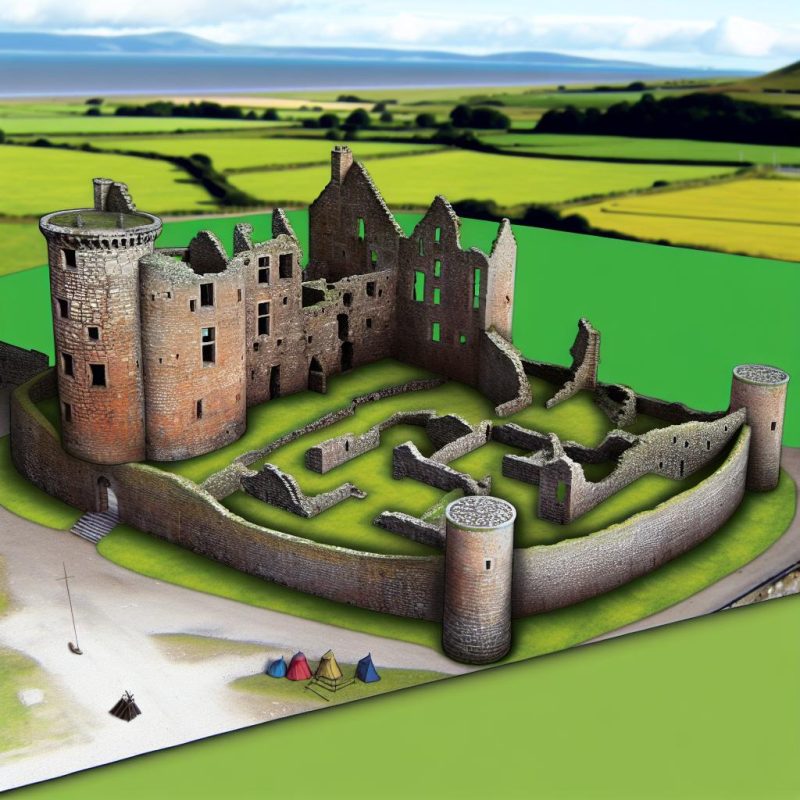Dunstaffnage Castle: An Overview
Dunstaffnage Castle, located a few miles north of the town of Oban on the west coast of Scotland, is a significant medieval fortification and one of Scotland’s oldest stone castles. Constructed in the 13th century by the MacDougall clan, the castle was strategically positioned on a rocky outcrop. This location not only provided a vantage point over Loch Etive but also controlled crucial maritime routes, underscoring the castle’s role in asserting regional dominance over the surrounding area.
Historical Significance
The importance of Dunstaffnage Castle extends beyond its architectural presence; it is essential to understanding Scotland’s medieval past. Its strategic location and robust structure made it a crucial defence point against a range of invaders and warring clans. During Scotland’s tumultuous medieval era, the castle was more than just a dwelling; it was a symbol of power and control. It played a pivotal role in repelling Norse invasions and stood at the intersection of regional power struggles. The castle frequently acted as a stronghold in the conflicts between the MacDougalls and other powerful families and the Scottish monarchy.
The Role of the MacDougall Clan
Initially, the castle was under the dominion of the MacDougall clan, a family lineage marked by its staunch support for the Lord of the Isles. The castle’s construction and initial phase of habitation were emblematic of the clan’s influence and ambitions. The MacDougalls’ association with the Dunstaffnage Castle was more than a simple matter of residency; it was indicative of their political machinations and regional influence. Their interactions with the Scottish kings reveal a complex web of alliances and conflicts that were instrumental in shaping the castle’s narrative. This tension offers insights into how local politics often intertwined with national issues during this era.
Transition of Ownership
The control of Dunstaffnage Castle shifted several times, particularly during the Wars of Scottish Independence in the late 13th and early 14th centuries. During this period, the castle changed hands between Scottish and English forces, signifying its tactical significance. However, by the 15th century, the Scottish Crown consolidated its control over Dunstaffnage, marking a pivotal turn in its history. The castle’s passage from MacDougall hands to Royal control symbolized the shifting power dynamics within Scotland. Later, in the 16th century, the castle was bestowed upon the Campbell family, underlining the family’s loyalty to the Scottish monarchy and its rising prominence in Scottish society.
Architectural Features
Dunstaffnage Castle is renowned for its enduring stone structure, which features a robust curtain wall and three distinctive round towers. This architecture is a testament to the military strategies of the medieval period, designed to resist sieges and attacks effectively. Over the centuries, the castle has undergone several modifications and repairs, each alteration weaving a new thread into its historical tapestry. While preserving its medieval ambiance, each layer of reconstruction reflects evolving architectural styles and influences. Notably, these modifications have managed to retain the essence of its original purpose while adapting to the changing needs of its occupants.
Historical Artifacts and Discoveries
The archaeological excavations conducted at Dunstaffnage Castle have been particularly fruitful, shedding light on the lives of its historic inhabitants. Artifacts such as ancient pottery fragments, weaponry, and various personal items have been unearthed, each piece offering a glimpse into the past. These discoveries have been crucial for historians and archaeologists alike, providing the necessary context to piece together the daily life, trade practices, and warfare tactics of the people who once resided within the castle walls. Such findings have painted a vivid picture of life in the Scottish Highlands during the medieval period, enriching our understanding of the era.
Legacy and Modern Relevance
Today, Dunstaffnage Castle stands not just as an architectural relic but as a monument reflecting Scotland’s intricate and eventful history. Its stories of defense, political intrigue, and clan rivalry serve as enduring narratives that highlight the dynamic nature of medieval Scottish society. The castle’s enduring presence also highlights its significance as a cultural touchstone that connects modern society to its historical roots.
Visitors to Dunstaffnage Castle in contemporary times are welcomed with a tangible connection to the past. It serves as a popular destination for those interested in history, archaeology, or simply the beauty of Scottish landscapes. As a preserved historic site, it offers educational opportunities and insights into the strategic importance it once held. Efforts by organizations like Historic Environment Scotland ensure that the castle remains accessible to the public, maintaining its status as an emblem of Scottish heritage and history.
Conclusion
In summary, Dunstaffnage Castle is more than a stronghold of stone; it is an embodiment of Scotland’s medieval epoch, marked by conflict, resilience, and transformation. The structure itself, along with the numerous artifacts found within, serves as a key to unlocking the stories of those who once called it home. Its transition through various hands, fortifications, and roles signifies the castle’s adaptability and enduring presence through centuries of Scottish history.
For those who wish to delve deeper into the narrative of Dunstaffnage Castle, visiting the castle provides a direct portal to Scotland’s rich historical landscape. By exploring the castle and its grounds, visitors can engage with the echoes of the past and gain a deeper appreciation for the strategic and cultural significance this fortress once held. Along with its historical resonance, Dunstaffnage today stands as a testimony to the complex socio-political fabric that has shaped Scotland over centuries, inviting both reflection and exploration for those eager to connect with the past.

